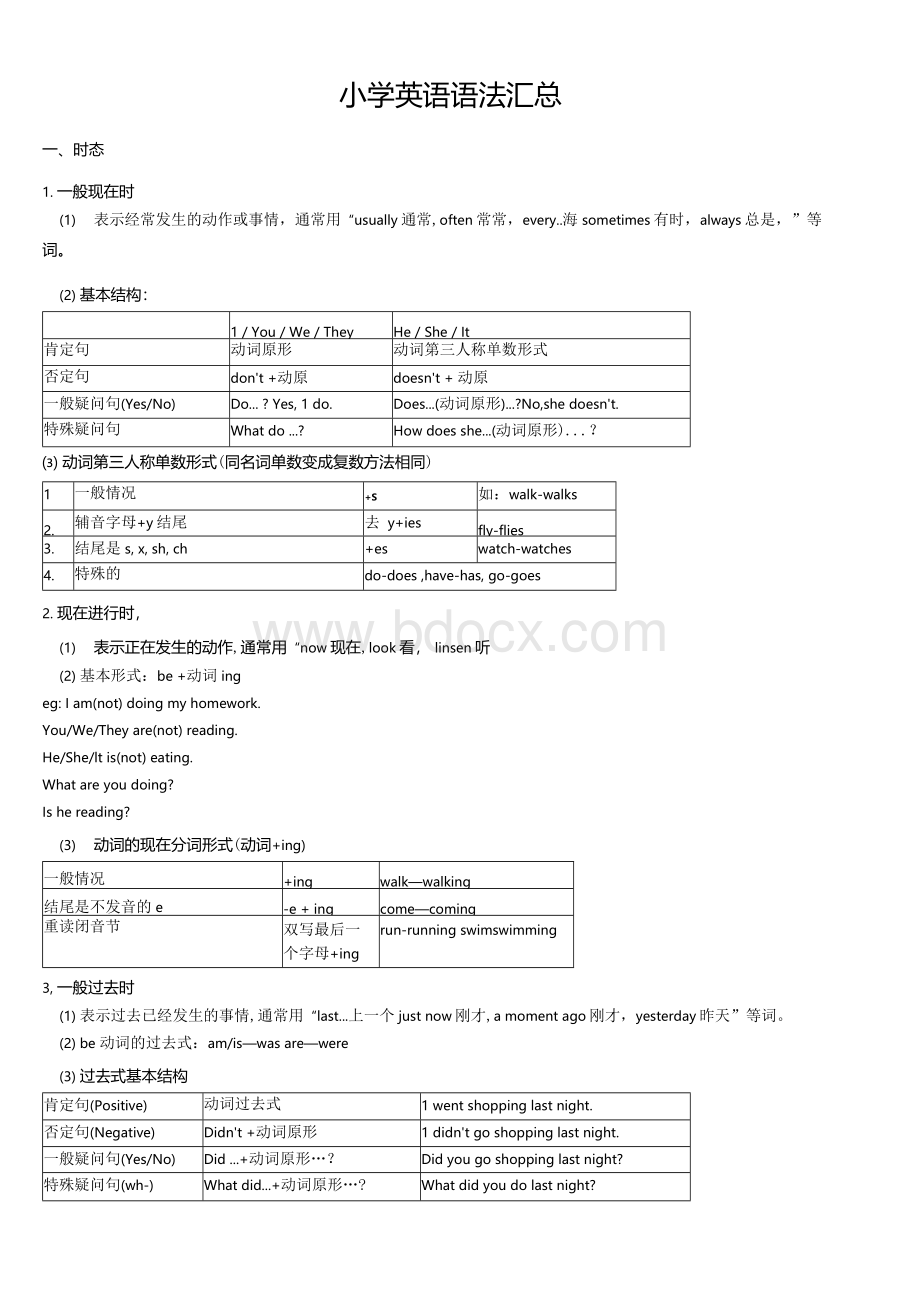小学英语语法总复习总结知识点归纳.docx
《小学英语语法总复习总结知识点归纳.docx》由会员分享,可在线阅读,更多相关《小学英语语法总复习总结知识点归纳.docx(11页珍藏版)》请在冰豆网上搜索。

小学英语语法汇总
一、时态
1.一般现在时
(1) 表示经常发生的动作或事情,通常用“usually通常,often常常,every..海sometimes有时,always总是,”等
词。
(2)基本结构:
1/You/We/They
He/She/It
肯定句
动词原形
动词第三人称单数形式
否定句
don't+动原
doesn't+动原
一般疑问句(Yes/No)
Do...?
Yes,1do.
Does...(动词原形)...?
No,shedoesn't.
特殊疑问句
Whatdo...?
Howdoesshe...(动词原形)...?
⑶动词第三人称单数形式(同名词单数变成复数方法相同)
1
一般情况
+S
如:
walk-walks
2.
辅音字母+y结尾
去y+ies
fly-flies
3.
结尾是s,x,sh,ch
+es
watch-watches
4.
特殊的
do-does,have-has,go-goes
2.现在进行时,
(1) 表示正在发生的动作,通常用“now现在,look看,linsen听
(2)基本形式:
be+动词ing
eg:
Iam(not)doingmyhomework.
You/We/Theyare(not)reading.
He/She/ltis(not)eating.
Whatareyoudoing?
Ishereading?
(3) 动词的现在分词形式(动词+ing)
一般情况
+ing
walk—walking
结尾是不发音的e
-e+ing
come—coming
重读闭音节
双写最后一个字母+ing
run-runningswim�swimming
3,一般过去时
(1)表示过去已经发生的事情,通常用“last...上一个justnow刚才,amomentago刚才,yesterday昨天”等词。
(2)be动词的过去式:
am/is—wasare—were
(3)过去式基本结构
肯定句(Positive)
动词过去式
1wentshoppinglastnight.
否定句(Negative)
Didn't+动词原形
1didn'tgoshoppinglastnight.
一般疑问句(Yes/No)
Did...+动词原形…?
Didyougoshoppinglastnight?
特殊疑问句(wh-)
Whatdid...+动词原形…?
Whatdidyoudolastnight?
(4)词过去式的变化:
规则动词的变化:
一般动词
+ed
planted,watered,climbed
以不发音的e结尾
+d
liked
辅音字母加y结尾
-y+ied
study—studied,cry-cried
重读闭音节单词,末尾只有一个辅音字母
双写最后一个字幕+ed
stop-stoppedplan-planned
4.一般将来时
一般将来时表示将来打算做的事或将要发生的事情。
常常与tomorrow,nextSunday等时间状语连用。
结构:
begoingto+动词原形或will+动词原形
例如:
I'mgoingtovisitmygrandpanextweek.
二、人称代词
主格
1
we
you
he
she
it
they
宾格
me
us
you
him
her
it
them
形容词性物主代词
my
our
your
his
her
its
their
名词性物主代词
mine
ours
yours
his
hers
its
theris
(注:
介词,动词后面跟宾格。
后面没有名词时用名词性物主代词。
)三、可数名词的复数形式
1.一般名词:
+sabook-books
2.辅音字母加v结尾:
-y+iesastory—stories
3.以s,x,sh,ch,结尾:
+esaglass—glasses;awatch-watches
4.以f或fe结尾:
-f或fe变为vesaknife-knivesashelf-shelves
5.特殊的名词复数
man-men,woman-women,policeman-policemen,policewoman-policewomen,mouse-micechild-childrenfoot-feet,.tooth-teethfish-fish,people-people,Chinese-Chinese,Japanese-Japanese
四、不可数名词(没有复数形式)
bread,rice,water,juice,milk,tea,coffee
五、缩略形式
I'm=Iamyou're=youareshe's=sheishe's=heis/hehas(got)
it's=itiswho's=whoiscan't=cannotisnt=isnotdidn,t=didnotweren?
t=werenotwasn't二wasnotlet,s=letusKll=lwill
六、a.an.the的用法
1.单词的第一读音是辅音读音:
abook,apeach,a"U〃
单词的第一个读音是元音读音:
anegg,anhour,an"F”
2.the要注意的:
球类前面不加the,乐器前面要加the,序数词前面要加the。
七、介词
原形
过去
原形
过去式
原形
过去式
原形
过去
sweep
式swept
teach
taught
have
had
go
式went
keep
kept
think
thought
do
did
find
foun
sleep
slept
buy
bought
eat
ate
say
dsaid
feel
felt
drink
drank
is/am
was
take
took
read
read
give
gave
are
were
mean
mean
put
put
sing
sang
drive
drove
meet
t
met
cut
cut
begin
began
speak
spoke
make
made
let
let
ring
rang
write
wrote
see
saw
fly
flew
run
ran
ride
rode
come
came
draw
drew
sit
sat
hear
heard
tell
told
grow
grew
learn
learned/learnt
get
got
know
knew
不规则动词的变化:
1.表示方位:
on,in,infrontof,between,nextto,near;beside,at,behind.,under
2.表示时间:
(1)at:
几点前面用at如:
atsixo'clock,没有day的节日前用at如:
atChristmas,固定词组attheweekends,atnight
(2)on:
星期前用on如:
onMonday,日期前用on如:
onthe15thofJuly带有Day的节日前用on如:
onNationalDay
(3)in:
早晨,中午,晚上前用in:
inthemorning,intheafternoon,intheevening,月份前用in,inDecember,季节前用in,如winter
八、基数词变成序数词的方法
1.直接在基数词词尾加上th。
如:
seventh第七,tenth第+,thirteenth第十三,2.以y结尾的基数词,变y为i,再加_hetho如:
twentieth第二十。
3.不规则的。
如:
first第一,second第二,third第三,fifth第五,eighth第八,ninth第九,twelfth第十二。
4.有两个或以上单词组成的基数词只改最后一个单词如twenty-first第二■"—。
九、some/any的用法
1.肯定句中用some:
Ihavesometoysinmybedroom.
2.问句和否定句中用ang:
Doyouhaveanybrothersorsisters?
Hehasn'tgotanypencilsinhispencil-case.
3.询问想要什么时用some:
Wouldyoulikesomejuice?
CanIhavesomestamps?
十、therebe结构
1.肯定句(有...):
Thereis+单数或不可数名词
Thereare+复数
注:
遵循就近原则,看靠therebe最近的
2.一般疑问句(有…吗?
):
lsthere...?
Yes,thereis./No,thereisn't.
Arethere...?
Yes,thereare./No,therearen't.
3.否定句(没有):
Thereisn't Therearen't
4.therebe句型与have(has)的区别:
therebe表示在某地有某物(或人);have(has)表示某人拥有某物。
H^一、祈使句
Sitdownplease
Don'tsitdown,please.
Let'sgotothepark.
(注:
祈使句中动词用原形)
十二、(情态)动词can,may,must,should,will后面直接用动词原形。
1.I/He/She/Theycansing.MayIcomein?
Imustgonow.
2.Youshouldbequietinthelibrary.
3.You'llbegoodfriends.
十三、形容词和副词的比较级
一、形容词的比较级
1.两个事物或人的比较用比较级,比较级后面一般带有单词thano比较级前面可以用more,alittle来修饰表示程度。
。
2.形容词加er的规则:
⑴一般在词尾加er;
⑵以字母e结尾,加r;
⑶以一个元音字母和一个辅音字母结尾,应双写末尾的辅音字母,再加er;
⑷以"辅音字母+y〃结尾,先把y变i,再加er。
3.不规则形容词比较级:
good-better,beautiful-morebeautiful
二、副词的比较级
1.形容词与副词的区别(有be用形,有形用be;有动用副,有副用动)
⑴在句子中形容词一般处于名词之前或be动词之后
⑵副词在句子中最常见的是处于实义动词之后
2.
副词比较级的变化规则基本与形容词比较级相同(不规则变化:
well-better,far-farther)十四、特殊疑问句
What
(问什么事,什么物或么